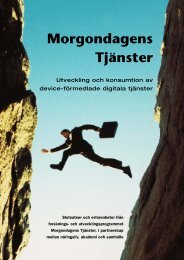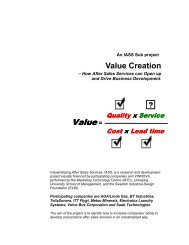INDUSTRIALIZING AFTER SALES SERVICES - MTC
INDUSTRIALIZING AFTER SALES SERVICES - MTC
INDUSTRIALIZING AFTER SALES SERVICES - MTC
You also want an ePaper? Increase the reach of your titles
YUMPU automatically turns print PDFs into web optimized ePapers that Google loves.
e-planning done by technicians are more easily done. In practice this means that<br />
technicians do not need to visit the local warehouse to receive assignments and that<br />
emergency and planned maintenance can be performed at the same time. A web application<br />
is also included for the call centre to monitor field service activities – a help for manual<br />
planning that sometimes is needed for emergency calls.<br />
Perform assignment. When service orders are sent to technicians, also service history,<br />
contracts and planned maintenance are shown in the hand-held computer. Drawings and<br />
supportive documentation can be retrieved directly by the technician. Ordering of spare parts<br />
and items available in the van can also be made visible in the field.<br />
Report. When the assignment is accomplished, the job is reported directly in the hand held<br />
computer. This is done step by step by specifying used time and material, which then is<br />
signed by the customer. Data quality is now radically higher than before.<br />
Invoice. After reporting the invoice is sent automatically, or by an intervening manual check<br />
up, to the customer. During this process customer contracts are also checked automatically.<br />
From an implementation perspective the initial effects were on planning / synchronization for<br />
the technician and the call centre to find suitable service people and doing several jobs at<br />
one occasion. Secondly improvements have become visible for the call centre in reporting<br />
and invoicing. However, the technicians have taken over activities from the call centre and<br />
have to some extent become less efficient in their more operative work. Also education has<br />
been needed to teach new planning procedures. Inventory control has slightly become better<br />
with less stocking costs and decreased throughput times, staffing has so far decreased in the<br />
call centre and there is an opportunity to restructure the organisation of the field service<br />
technicians. For the customers, the quality of service has incrementally increased and also<br />
the service availability has become better. On the other hand there have been negative<br />
effects on personal communication. Possible technical extensions are to connect a web<br />
based interface with customers and to change the work routines for the field technicians. The<br />
field service process has become more automated, with some manual intervention, and<br />
resources have been released for other use. Improvements have been made in several steps<br />
both on the customer and the provider side.<br />
Assessment of the BT case<br />
An important part in industrializing services is the evaluation phase. In the EASY project this<br />
was a key aspect already integrated in the initial plan. After the pre-study and the<br />
implementation in Sweden, Belgium and Great Britan the whole concept was evaluated and<br />
related to the investment cost by calculating payback times, changes in return on capital<br />
employed, efficiency gains and return on investment. Examples of indicators from these<br />
evaluations can be seen in Table 2.<br />
Table 2: Some evaluation indicators<br />
Indicators<br />
•No of Worksheets copy<br />
•Feedback of worksheets<br />
•Parts replenishment<br />
•Rolling planning<br />
•Input of information<br />
•Order spare parts direct<br />
•Auto directed allocation<br />
>3<br />
1-14 days<br />
3-14 days<br />
Monthly<br />
2 or more<br />
No<br />
No<br />
Before<br />
0-1<br />




